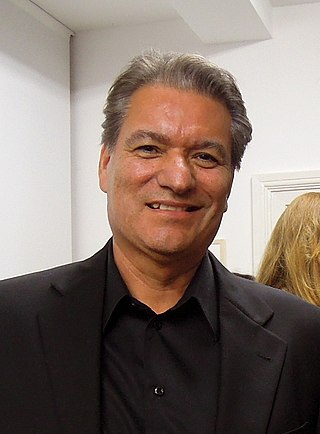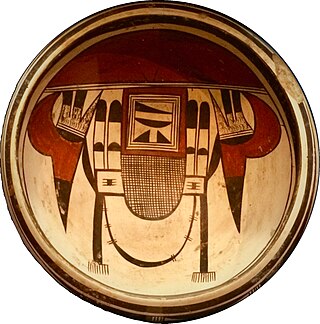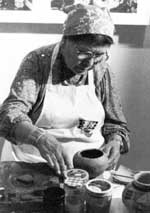
The Hopi are Native Americans who primarily live in northeastern Arizona. The majority are enrolled in the Hopi Tribe of Arizona and live on the Hopi Reservation in northeastern Arizona; however, some Hopi people are enrolled in the Colorado River Indian Tribes of the Colorado River Indian Reservation at the border of Arizona and California.

Second Mesa is a census-designated place (CDP) in Navajo County, Arizona, on the Hopi Reservation, atop the 5,700-foot mesa. As of the 2020 census, the CDP population was 843, spread among three Hopi Indian villages, Musungnuvi, Supawlavi, and Songoopavi. The Hopi Cultural Center is on Second Mesa.
Hopi is a Uto-Aztecan language spoken by the Hopi people of northeastern Arizona, United States.

Nampeyo was a Hopi-Tewa potter who lived on the Hopi Reservation in Arizona. Her Tewa name was also spelled Num-pa-yu, meaning "snake that does not bite". Her name is also cited as "Nung-beh-yong," Tewa for Sand Snake.

The Tewa are a linguistic group of Pueblo Native Americans who speak the Tewa language and share the Pueblo culture. Their homelands are on or near the Rio Grande in New Mexico north of Santa Fe. They comprise the following communities:

The Hopi Reservation is a Native American reservation for the Hopi and Arizona Tewa people, surrounded entirely by the Navajo Nation, in Navajo and Coconino counties in north-eastern Arizona, United States. The site has a land area of 2,531.773 sq mi (6,557.262 km2) and as of the 2000 census had a population of 6,946.
The Hopi-Tewa are a Tewa Pueblo group that resides on the eastern part of the Hopi Reservation on or near First Mesa in northeastern Arizona.

Dan Namingha is a Hopi painter and sculptor. He is Dextra Quotskuyva's son, and a great-great-grandson of Nampeyo. He is a member of the Hopi-Tewa member of the Hopi Tribe. He lives in Santa Fe, New Mexico.

Fannie Nampeyo (1900–1987) was a modern and contemporary fine arts potter, who carried on the traditions of her famous mother, Nampeyo of Hano, the grand matriarch of modern Hopi pottery.
Elva Nampeyo (1926–1985) was an American studio potter.

Tuba was a Hopi leader in the late 19th century. Tuba was the headman of the small Hopi village of Moencopi, roughly fifty miles west of the main villages on the Hopi mesas. However, he apparently was an important person in the village of Oraibi as well. Eventually, Tuba joined the Church of Jesus Christ of Latter-day Saints and later received his endowment in the St. George Temple. Tuba City, Arizona, was named in his honor.
KUYI 88.1 FM, is a Native American Public Radio station in Keams Canyon, Arizona. The station, founded in 2000, primarily features locally produced programming for the Hopi, Tewa, and Navajo Native American tribal residents, surrounding communities in Northern Arizona, the Four Corners areas and streaming worldwide. Other network programming is provided by Native Voice One. Top of the hour news updates from National Public Radio are aired Monday through Friday. Its musical programming is a mix of traditional Hopi and modern music.

Art of the American Southwest is the visual arts of the Southwestern United States. This region encompasses Arizona, New Mexico, and parts of California, Colorado, Nevada, Texas, and Utah. These arts include architecture, ceramics, drawing, filmmaking, painting, photography, sculpture, printmaking, and other media, ranging from the ancient past to the contemporary arts of the present day.
Arizona, a state in the southwestern region of the United States of America, is known for its high population of Native Americans. Arizona has the third highest number of Native Americans of any state in the Union. Out of the entire US population of 2.9 million Native Americans, roughly 286,680 live in Arizona, representing 10% of the country's total Native American population. Only California and Oklahoma have more Native Americans than Arizona by number. Arizona also has the highest proportion of land allocated to Native American reservations, at 28%. Arizona has five of the twelve largest Indian reservations in the United States, including the largest, the Navajo Nation, and the third-largest, the Tohono O'odham Nation. Also, Arizona has the largest number of Native American language speakers in the United States.
Neil Randall David Sr. is an American artist and katsina carver. He learned the basics of carving from his grandfather Victor (Kawayo) Charlie.
Grace Chapella (1874–1980) was a renowned Hopi-Tewa potter from a Tewa village and of the Bear Clan.

Priscilla Namingha Nampeyo was a Hopi-Tewa potter who was known for her traditional pottery. Namingha mined her own clay and created her own pigments for her large pots. Her work is in the collection of several museums and cultural centers.

The Hopi Cultural Center is a place in the Hopi Reservation on Second Mesa, Arizona where visitors can learn about the culture, history and art of the Hopi people. It also provides lodging and a restaurant that serves Hopi cuisine. A museum is also part of the cultural center. Hopi ceremonies also take place at the center, although many of these are not open to the public.

Daisy Hooee Nampeyo was a Hopi-Tewa potter. She studied at École des Beaux-Arts. Hooee taught pottery making on the Zuni reservation and helped preserve the traditional techniques she learned from her grandmother, Nampeyo.

Albert Yava (1888–1980) was a Hopi–Tewa autobiographer and interpreter. Born in Tewa Village on First Mesa, Arizona, in 1888 to a Hopi father and a Tewa mother, Yava's given name was Nuvayoiyava, meaning Big Falling Snow. He attended primary school in Polacca, Arizona, at a time when compulsory education at US government-run schools was a controversial topic in the Hopi community. Teachers at the school shortened his name to Yava and added the familiar name Albert, both of which names he used for the remainder of his life. Yava subsequently attended boarding school in Keams Canyon, Arizona and spent five years at the Chilocco Indian School in Oklahoma.


















